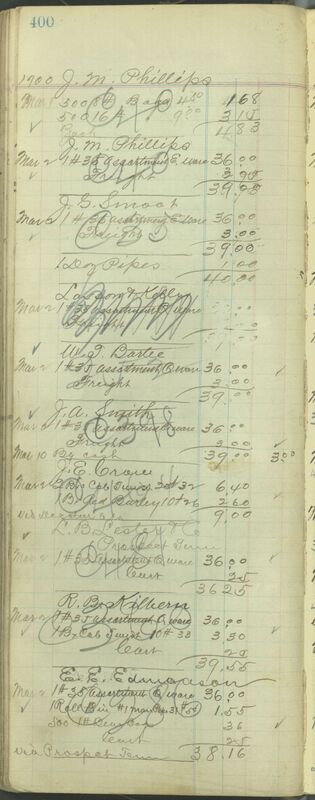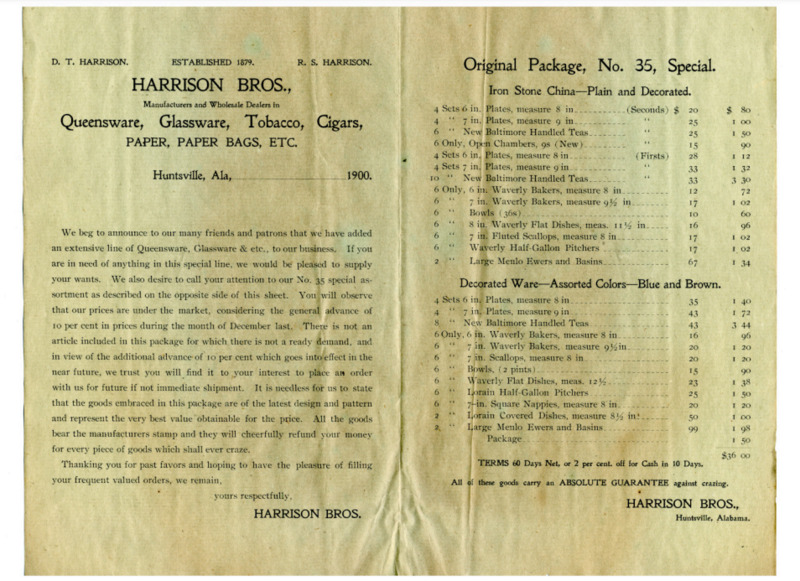Harrison Brothers Queensware
In March 1900, the changes in industry and population in Huntsville began to affect the Harrison Brothers' store. On March 2, Harrison Brothers sold its first #35 Assortment and Ware. The Harrison Brothers’ drastic switch from tobacco to Queensware, cheap earthen whiteware, was a result of the changes in the city around them. Every week in the first few months of 1900, the Huntsville Weekly Democrat raved about the construction of the Dallas Mill addition and the Merrimack mill, the influx of working-class individuals to mill villages, and the construction of homes all around the city.[1] The merchants in Courthouse Square were preparing for the arrival of new consumers, not just mill workers, but also businessmen and merchants convinced of Huntsville’s prosperity by the city’s promotional campaign. The small-town enterprise that the Harrison Brothers had created had to quickly adapt to a changing demographic, new competition, and innovation in technology in the city. The Huntsville electric streetcar, completed in early March 1900, ran through Commercial Row and promised new business to the merchants on the square.
According to a 1901 Sanborn Fire Insurance Map, the primary product sold at Harrison Brothers was “Queensw.”[2] Queensware is a term colloquially referring to cheap earthen whiteware made in English-immigrant potter communities such as East Liverpool, Ohio. On March 2, 1900, Harrison Brothers sold the first “#35 Assortment and Ware.”[3] This $36 bulk order of assorted tableware was a Harrison Brothers special, ordered by mail and carried in by freight car. Due to the high price of the bulk product, Queensware at Harrison Brothers did not immediately gain traction. Harrison Brothers continued selling tobacco products, with limited options, along with the occasional #35 Special throughout March 1900.
On March 8, 1900, J.W. Barnard and Bros. were the first customers to purchase individual pieces of Queensware. Barnard and Bros. purchased 61 individual items for $19.48 which was cheaper than the #35 Special. Each individual item in this purchase only cost $0.40 to $1.50.[4] The expansion of merchandise made Queensware at Harrison Brothers accessible to more people. Harrison Brothers Tobacco catered to the luxury needs of the upper and middle-class of old-Huntsville, but Harrison Brothers Queensware had something for everyone. Throughout the rest of March, customers purchased the #35 Assortment and Ware and individual products, but many loyal tobacco customers paid off their remaining credit debt and closed their customer accounts as the store minimized its tobacco inventory.[5] By April, Harrison Brothers had solid interest in Queensware, but it was the cotton mill workers who truly took advantage of the cheap product.
History of Queensware
When Josiah Wedgewood of Staffordshire, England, created his cream-colored earthenware in the 1760s, it was praised for its white, porcelain-like color. Queen Charlotte appointed Wedgewood as her “Potter to Her Majesty” and his cream-colored ware, and most of the wares from Staffordshire were referred to as “Queen’s Ware.” The Staffordshire creamwares were popular among the English aristocracy, but their cheaper earthen wares were more popular abroad in the United States in the late nineteenth century. Staffordshire potters that could not compete in the English-quality market moved to the United States and established English pottery communities along the Delaware and Ohio Rivers in Trenton, NJ and East Liverpool, Ohio. The Harrison Brothers bought their first Queensware products from Harker Pottery Company and Steubenville Pottery Company in Ohio. English potters had to adopt new techniques to work with the American clay and their pottery was not porcelain-like like Wedgewood’s Queen’s Ware. However, the English potters still marketed their cheap earthen wares as Queensware to fulfill the American desire for luxury goods at affordable prices. In the 1870s and 1880s, English-American potters developed mechanical processes to make and decorate their products creating less unique items but manufacturing more at lower production cost. Because of these industrial advances, Queensware, and general table and toilet ware pottery, became common household items, even for poor working-class individuals. Despite its cheap price, these staple products were an easy way to bring refinement and class to any home.[7]
Footnotes
[1] Huntsville Weekly Democrat, February 28, 1900.
[2] Sanborn Fire Insurance Map from Huntsville, Madison County, Alabama. Samborn Map Company, 1901.
[3] "Daybook 2", Harrison Brothers Hardware, UAH ASCDI.
[4] "Daybook 2", Harrison Brothers Hardware, UAH ASCDI.
[5] "Daybook 2", Harrison Brothers Hardware, UAH ASCDI.
[6] F. Thistlethwaite, "TheAtlantic Migration of the Pottery Industry," The Ecoomic History Review, 11 (1958), 264-278. https://www.jstor.org/stable/2592320





